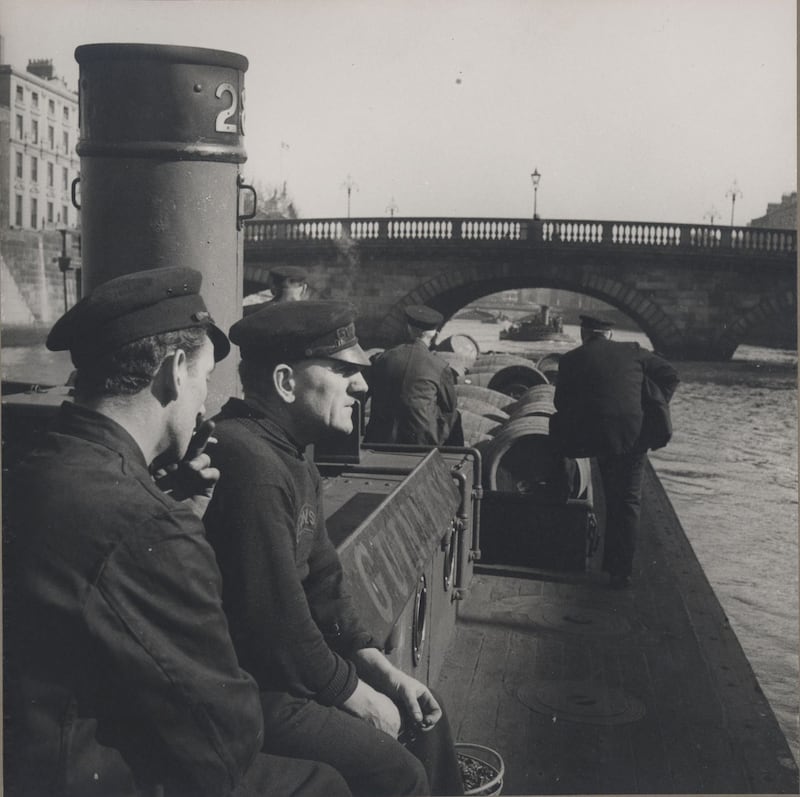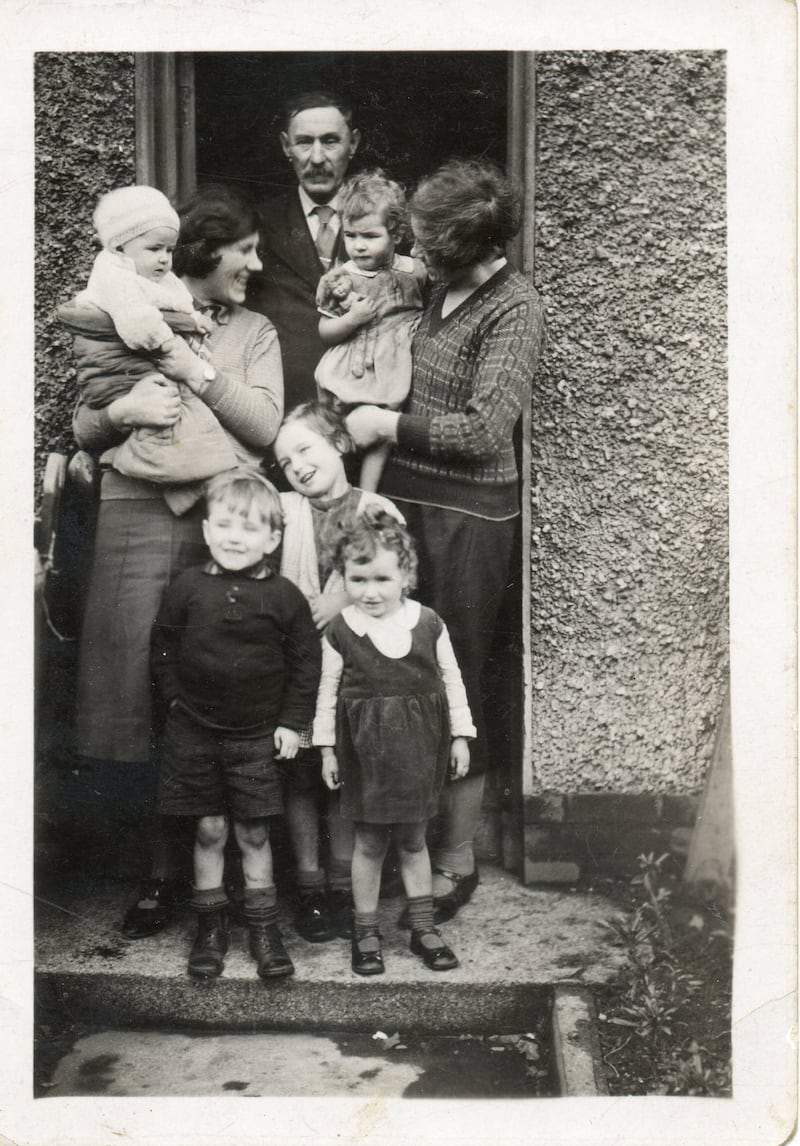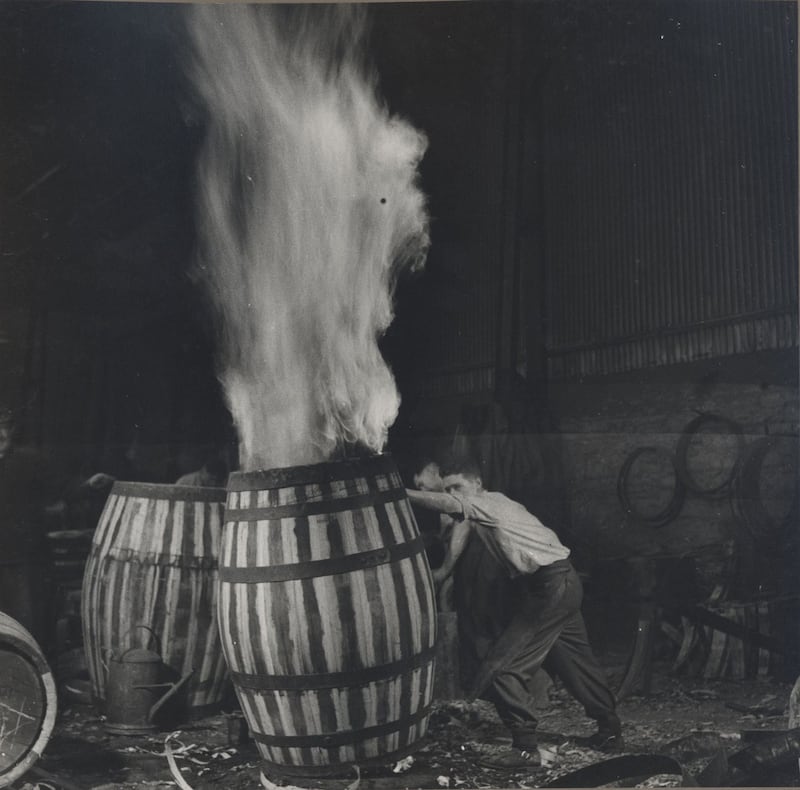It was terrible weather for delivering porter. According to that day's Irish Times the forecast for Thursday, December 8th, 1910, was "south-easterly and easterly winds, strong to a gale, squally, unsettled; some rain, fair intervals; mild".
Shortly before noon John Russell, 41 years old, and living in Dublin for six years after moving up from Cork, was in Glasnevin, dropping off barrels of porter, when he tumbled backwards off the Guinness cart and cut his head.
“Fell off lorry, through pulling an empty cask in mistake for a full one,” the medical officer wrote in a notice of accident from the brewery. A comical way to lose your balance, but I feel for John Russell, a man I never met but who was my great-grandfather.
0 of 4
My mother, Dolores, and I are looking through a batch of off-white documents from a narrow yellow envelope on a table in a side room near the Guinness Storehouse while Fergus Brady, an archivist, talks us through them.

Reading of John Russell's fall, my mother is both surprised and moved. She remembers singing for him The Banks of My Own Lovely Lee in the house in Fairbrothers' Fields in the 1950s. John would face the fireplace with his back turned away, so his young granddaughter couldn't see his tears.
How oft do my thoughts in their fancy take flight, to the home of my childhood away.
Cork through and through, he was, and the lyrics meant a lot to him. He liked to refer to the seven girls in the family as his bevy of beauties.
What looks like a dry batch of paperwork –
lists of applications for housing, notes on when he started work, a meticulous laying out of the life of a drayman who delivered porter in the first half of the 20th century – has brought John Russell to life.
“Your reaction and experience are very common,” says Brady. The Guinness archives contain 20,000 personnel files, making them one of the most comprehensive corporate archives in the world.
Researchers are often moved by discovering such a vivid record of their ancestor's life, and feel closer to their relative as a result of the experience.
There is also a lot of joy in making unexpected discoveries. Finally, for many people, knowing more about their ancestors reinforces their own sense of self and identity.
Guinness was known as an employer for life, a company that looked after you, and there weren’t many of those around in the early part of the last century, especially not for labourers and unqualified workers. In the late 19th and early 20th centuries employment could stretch to 50 years or more. Draymen took pride in their bowler hats and long overcoats, and in the smooth gloss of their horses’ coats.
“The files regularly paint a vivid picture of the employee’s life, as they often include minute detail concerning weight and height, colour of hair and eyes, and the employee’s signature. Often researchers will say things like, ‘So that’s where the brown eyes in the family come from.’
“The community aspect of the brewery is often reflected in the files, as many of the family historians who visit us discover to their surprise that successive generations of their family worked at St James’s Gate brewery,” Brady says.
Facebook post
I first became aware of the archives’ work through my cousin Peter Ignazi, in Toronto, who posted information he had found online about John on Facebook.
During a tourism-trade delegation to China, where I am Beijing correspondent for The Irish Times, I ran into the Guinness Storehouse's business-development manager, Fiona Herald, who encouraged me to take the research further and who set up our meeting in the archives with Brady.
Every year the archives get about 500 genealogy queries, each of them often about more than one person, because many people have a number of relatives who worked at the brewery. Relatives also come in while visiting the Storehouse.
The files date mainly from between the incorporation of the company, in 1886, and the 1960s, but they also include the original 1759 lease for the brewery and go right up to the present day. The archive holds more than 7,000 linear metres of files, ledgers, maps and posters related to all areas of the brewery’s work, plus 10,000 photographs and films and a growing collection of digital records.

“I think that people are most interested in the little personal details they find in the files. We find that family historians typically come to us with straightforward requests concerning their ancestors, hoping to find out a little information on dates of birth and death, dates of employment and the role in which their ancestor worked in the brewery,” Brady says. The information helps to expand the snippets of data available in other regularly accessed genealogy sources, such as parish records and the 1901 and 1911 censuses online.
John Russell was born on October 3rd, 1868, a year when Jesse James was robbing banks across the Wild West and when the Meiji Restoration returned authority to Japan’s emperors.
It was a period of great expansion at the brewery, too. This was six years after Guinness adopted its trademark oval label, with its harp and Arthur Guinness’s signature.
That year Benjamin Lee Guinness died, and the brewery passed to his son Edward Cecil Guinness. Under him the brewery doubled in size, spreading north to bound the River Liffey, where the brewery bought land and built a jetty for its fleet of barges.
The brewery’s expansion also included a cooperage, a racking shed, a maltings, an internal railway, a new vat house and a storehouse for fermenting vessels.
In 1892 – the year the Irish Education Act introduced free primary schooling and compulsory education to the age of 14, and Oscar Wilde first staged Lady Windermere's Fan in London – my great-grandfather started work at the brewery in Cork.
He joined the stabling department in Cork Stores on April 18th, 1892, aged 24. His employee number was 6049, and his character was described, in a beautifully handwritten note, as good.
On October 8th, 1898, John married Lizzie Goulding; they lived on Caroline Street in Cork.
John moved to Dublin in the fourth year of the new century, about to embark on a new chapter of his life. On April 20th, 1904, as a 36-year-old married man, he applied for workmen’s dwellings, at 62 Bellevue Buildings.
Lizzie initially stayed in Cork with their daughters, Mary and Kathleen – my grandmother – and their sons James, William and Edmund. James, or Jimmy, went on to work at the brewery. Another son mentioned in the 1901 census, Philip, died young.

The family joined my great-grandfather, and in 1915, having outgrown their lodgings, applied for three rooms in the Thomas Court Buildings. By then the boys were aged 15, 11 and 10 and the girls were 13 and eight.
“Would you kindly let me know [if] you consider he would prove a suitable tenant?” was the question from the register department. The application was rejected on May 27th with a note that said “Family too large”. Eventually they moved to 31 Bellevue Buildings.
Jimmy, employee number 13614, joined Guinness on February 20th, 1914, on the boys’ list initially.
Family history
My cousin Edmund Brennan has been researching the family since 1993. “They were hardworking,” he says of our ancestors.
Back then you worked or you or your family didn't eat. You had to keep going.
The day started at 6am, mucking out the stalls, before delivering the stout to “Town” and “Vicinity”. In 1919, after working time was moderated, a typical week was between 44 and 48 hours.
By 1925 the family was living on O’Curry Avenue, in Fairbrothers’ Fields in the Liberties, an area previously known as Tenters’ Fields because of the tenterhooks from which weavers hung their cloth. The area is on maps of Dublin from the 1600s.
“The house in O’Curry Avenue was state of the art at the time, with running water, its own toilet in the yard,” Edmund says; he grew up in the house when it was passed on to his family.
On June 9th, 1921, Jimmy Russell was interned by the military. He was released on December 9th of that year, and reinstated in employment in January 1922, but there are no details about his case.
Fergus Brady says that in a report from September 1922 the managing director of Guinness, CE Sutton, wrote, “We have had a few cases in which men have been arrested and as a result thereof imprisoned and subsequently discharged from custody, without any charge being proved against them.”

It’s possible that this is what happened to Jimmy. Guinness was a strong supporter of the Free State government during the Civil War, and James is unlikely to have been reinstated at the brewery had any involvement in the anti-Treaty forces been proven.
On July 30th, 1925, a memorandum from the traffic department to the registrar recommended that John Russell be given extra sick allowance. It said, very briefly, “got right shoulder hurt, and abrasion on right knee, through horse ‘Eclipse’ falling”.
Eclipse, which would have pulled John’s dray, is mentioned a couple of times in the documents.
My great-grandfather’s story at Guinness is interlinked with that of the horse, which was part of a method of transportation that the company used for just over 200 years: its last horse-drawn delivery was in 1960.
The brewery had its own Clydesdales and percherons, and from 1874 it hired horses from Richardson & Sons, on Tara Street. The brewery switched to trucks in July 1932, but Richardson’s provided horses until the end.
On September 17th, 1930, John received another increase in his sick pay, because
when going down the steps at the tunnel, he slipped and fell, striking his left elbow against step. He resumed work with 'some stiffness in left arm'
John was proposed for a pension at the end of 1931, when he was 63 years and two months, after 39 years and eight months of service. A medical report from November 25th describes the family circumstances: “Married – three boys and two girls (three boys working and two girls married).”
Social contract
There is a certain sense of satisfaction in the report, of a social contract fulfilled. It describes his character and efficiency as “good”, although he missed 53½ days through sickness in the two years leading up to his retirement. The report also notes his “chronic dyspepsia” but adds, in the category Expectation of Life, that John “may attain expectations”.
On December 3rd, 1931, he was given a pension of 57 shillings a week, to start on January 1st, 1932. (By this time his son Eddie had gone to the United States, to work at the Stern Brothers department store in New York, and would join the US military as a draftee in 1943.)
The letter announcing that John had ceased to work used the word “good” for all three categories: character, efficiency and attendance. Character was the most important quality in Guinness’s eyes.
The paternalistic tone of many of the documents is occasionally jarring, but he still had a good pension for the remaining 21 years of his life.
Little more was recorded in the Guinness records thereafter, although he was given a loan to help buy dentures in 1939.
The bottom of the envelope notes that John Russell died on January 19th, 1953, the year that Arthur Miller's The Crucible and Ernest Hemingway's The Old Man and the Sea were published and that Edmund Hillary became the first westerner to climb Everest.
For a few days I was telling Mammy he was breathing funny. He went to the brewery doctor and subsequently moved up to our house on Crumlin Road, where Mammy nursed him until he passed away. I came in from school and I cried for days
The event was marked on January 20th in a note from the registry on the return pension form for the chief medical officer. A memorandum that day spelled out my great-grandfather’s life: Reg No 6049, Grade 3 Drayman, who died aged 84 and 3/12 years and gave 39 and 8/12 years of service, his 21 years on the pension list, and his widower status, as Lizzie had predeceased him in 1940.”
He died at 58 Crumlin Road, where my mother grew up. Written beside “Memorandum” are the words “Off all books.”












